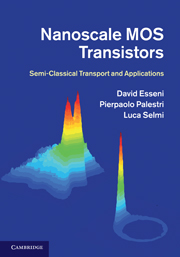Book contents
- Frontmatter
- Contents
- Preface
- Acknowledgements
- Terminology
- 1 Introduction
- 2 Bulk semiconductors and the semi-classical model
- 3 Quantum confined inversion layers
- 4 Carrier scattering in silicon MOS transistors
- 5 The Boltzmann transport equation
- 6 The Monte Carlo method for the Boltzmann transport equation
- 7 Simulation of bulk and SOI silicon MOSFETs
- 8 MOS transistors with arbitrary crystal orientation
- 9 MOS transistors with strained silicon channel
- 10 MOS transistors with alternative materials
- Appendices
- Index
6 - The Monte Carlo method for the Boltzmann transport equation
Published online by Cambridge University Press: 05 August 2011
- Frontmatter
- Contents
- Preface
- Acknowledgements
- Terminology
- 1 Introduction
- 2 Bulk semiconductors and the semi-classical model
- 3 Quantum confined inversion layers
- 4 Carrier scattering in silicon MOS transistors
- 5 The Boltzmann transport equation
- 6 The Monte Carlo method for the Boltzmann transport equation
- 7 Simulation of bulk and SOI silicon MOSFETs
- 8 MOS transistors with arbitrary crystal orientation
- 9 MOS transistors with strained silicon channel
- 10 MOS transistors with alternative materials
- Appendices
- Index
Summary
The Boltzmann Transport Equation (BTE) is an integro-differential equation where the unknown occupation function f depends on up to seven independent variables for a 3D carrier gas and five for a 2D carrier gas: the real and momentum space coordinates and the time. The equation is also non-linear due to the (1 - f) terms in the collision integral (Eq.5.9). Symmetries in the simulated device structure can reduce the number of variables in real-space, but the problem still remains very hard to solve with standard numerical methods [1].
In the previous chapter we examined ways to solve the BTE under various simplifying assumptions: absence of scattering (that is, ballistic transport), momentum-relaxation-time approximation for near equilibrium conduction in a low and uniform electric field, solutions via the moments of the BTE as in the Drift–Diffusion model.
Modern MOS transistors operate in a regime of transport where the number of scattering events suffered by the carriers traveling along the channel is largely reduced compared to long-channel devices, leading to quasi-ballistic transport, as described in Section 5.7. In this situation the distribution function is quite different from an equilibrium distribution and the simulation approaches relying on the moments of the BTE become inadequate [2, 3], thus demanding an exact solution of the BTE.
The Monte Carlo (MC) method is a powerful technique for solving exactly the semi classical BTE without a-priori assumptions on the carrier distribution function [4–7].
- Type
- Chapter
- Information
- Nanoscale MOS TransistorsSemi-Classical Transport and Applications, pp. 268 - 313Publisher: Cambridge University PressPrint publication year: 2011



